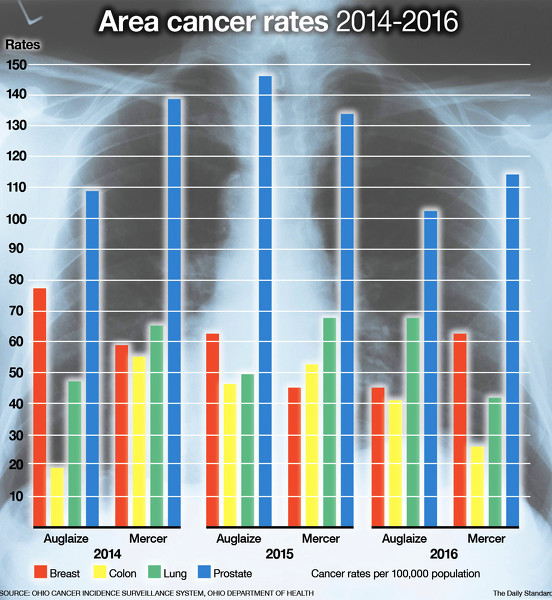Thursday, September 19th, 2019
Prostate cancer rates are high
By Leslie Gartrell

Photo by Daily Standard Staff
Shown are the rates of breast, colon, lung and prostate cancers in Mercer and Auglaize county for the years 2014 to 2016.
CELINA - September is National Prostate Cancer Awareness Month, and Mercer and Auglaize County residents can take steps to learn about prostate cancer and other prevalent cancers to help lower their risks.
According to the Ohio Department of Health's 2019 Mercer County Cancer Profile, prostate cancer was the most commonly diagnosed cancer in the county from 2012-2016, followed by lung and bronchus, female breast, colon and rectum cancer and melanoma of the skin, all of which represent 56% of all invasive cancer cases.
Prostate cancer accounted for 14.5% of cancer cases, while lung and bronchus cancer was the leading cause of cancer mortality, accounting for 23.5% of cancer deaths, according to the profile.
According to ODH's 2019 Auglaize County Cancer Profile, female breast cancer was the most commonly diagnosed cancer in the county in the same time period, followed by lung and bronchus, prostate, colon and rectum cancer and melanoma of the skin, also representing 56% of all invasive cancer cases.
Female breast cancer accounted for 14.3% of newly diagnosed cancer cases in Auglaize County. Lung and bronchus cancer was the leading cause of cancer death, accounting for 26.2% of cancer deaths in the county, according to the profile.
According to ODH, modifiable cancer risk factors include health behaviors and lifestyle factors, such as tobacco use, obesity and lack of physical activity, adding it's often not just one factor that increases a person's risk of developing cancer. Rather, cancer most often results from a complex interaction of multiple factors.
The percentage of adults who were obese in Mercer County in 2015 was 32.2%, compared with 31.8% in Ohio and 29% in the U.S., according to Mercer County's ODH cancer profile.
The profile continues, saying the percentage of adults who reported no leisure-time physical activity in Mercer County in 2015 was 25.2%, compared with 24.6% in Ohio and 22% in the U.S.
The percentage of adults who were obese in Auglaize County was 35.1%, according to Auglaize County's ODH cancer profile. The percentage of adults who reported no leisure-time physical activity in Auglaize County was 29.5%.
Being overweight and obesity are associated with at least 13 types of cancer, according to ODH. Nearly one-fifth of cancer deaths could be prevented by adopting healthy diet and exercise practices.
For example, the National Cancer Institute has said some studies have shown that diets high in fat, proteins, calories and red meat as well as drinking alcohol increase the risk of colorectal cancer.
ODH continued, saying tobacco use is associated with 12 types of cancer. Nearly one-third of all cancer deaths could be prevented by eliminating tobacco use, according to the NCI.
The percentage of adults in Mercer County who were smokers in 2016 was 16.2%, compared with 22.5% in Ohio and 17% in the U.S., according to the county's cancer profile.
According to Auglaize County's cancer profile, the percentage of adults who were smokers in 2016 was 18.7%.
Local residents should also consider testing their homes for radon. According to the U.S. Environmental Protection Agency, radon is the second-leading cause of lung cancer, and the gas can seep into homes.
Mercer County has been designated as a zone 1 area on the EPA's radon map, meaning the EPA predicts homes within the area could have high radon levels.
Radon is measured in picocuries per liter (pCi/L), and the EPA has identified 4 pCi/L as a recommended action level.
According to the university of Toledo's Radon Information System, the maximum rating for Mercer County was 56.1 pCi/L, the minimum Mercer County reading was 0.1 pCi/L, with an average reading of 6.8 pCi/L.
Homeowners can visit uchd.net/radon to get a radon test kit.
Overall, the NCI has suggested increasing protective factors, such as quitting smoking and exercising, may help prevent some cancers. People should speak with their doctor or other health care professional about how they might lower their risk of cancer.





